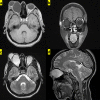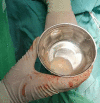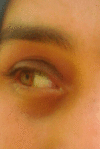Successful eradication of a large orbital hydatid cyst without rupture using fronto-orbitozygomatic approach, the first case reported from Syria
- PMID: 33133496
- PMCID: PMC7584460
- DOI: 10.1093/jscr/rjaa357
Successful eradication of a large orbital hydatid cyst without rupture using fronto-orbitozygomatic approach, the first case reported from Syria
Abstract
Hydatid disease is a parasitic infection resulted by Echinococcus granulosus in the larval stage and is most prevalent in the Middle East, India, Africa, South America, New Zealand, Australia, Turkey and Southern Europe. However, orbital hydatid cysts are rare and represent a challenge to the surgeon to eradicate the cyst without rupture. Here, we report a case of a relatively large primary intraconal orbital cyst in a 21-year-old woman. We managed to eradicate the cyst without any complication using fronto-orbitozygomatic approach, and the patient remained disease free after the 3 months of follow-up.
Published by Oxford University Press and JSCR Publishing Ltd. All rights reserved. © The Author(s) 2020.
Figures




Similar articles
-
Traumatic rupture of a solitary splenic hydatid cyst: A case report.Trauma Case Rep. 2015 Apr 23;1(1-2):1-3. doi: 10.1016/j.tcr.2015.02.001. eCollection 2015 Feb. Trauma Case Rep. 2015. PMID: 30101166 Free PMC article.
-
Spontaneous Hepatic Hydatid Cyst Rupture Into the Transverse Colon.Cureus. 2021 Jul 31;13(7):e16799. doi: 10.7759/cureus.16799. eCollection 2021 Jul. Cureus. 2021. PMID: 34513405 Free PMC article.
-
Primary Orbital Hydatid Cyst: A Case Report.Acta Med Iran. 2017 Aug;55(8):530-532. Acta Med Iran. 2017. PMID: 29034651
-
Hydatidosis of infratemporal fossa with proptosis - an unusual presentation: a case report and review of the literature.J Med Case Rep. 2018 Oct 17;12(1):309. doi: 10.1186/s13256-018-1812-y. J Med Case Rep. 2018. PMID: 30326941 Free PMC article. Review.
-
Cerebral intraventricular echinococcosis in an adult.Surg Neurol Int. 2015 Aug 18;6:138. doi: 10.4103/2152-7806.163177. eCollection 2015. Surg Neurol Int. 2015. PMID: 26392915 Free PMC article. Review.
Cited by
-
Orbital hydatid cyst from Echinococcus granulosus: a case report.J Surg Case Rep. 2025 Mar 12;2025(3):rjaf135. doi: 10.1093/jscr/rjaf135. eCollection 2025 Mar. J Surg Case Rep. 2025. PMID: 40079040 Free PMC article.
References
-
- Turgut AT, Turgut M, Koşar U. Hydatidosis of the orbit in Turkey: results from review of the literature 1963-2001. Int Ophthalmol. 2004;25:193–200. - PubMed
-
- Benazzou S, Arkha Y, Derraz S, El Ouahabi A, El Khamlichi A. Orbital hydatid cyst: review of 10 cases. J Cranio-Maxillofacial Surg. 2010;38:274–8. - PubMed
-
- Xiao A, Xueyi C. Hydatid cysts of the orbit in Xinjiang: a review of 18 cases. Orbit. 1999;18:151–5. - PubMed
-
- Limaiem F, Bellil S, Bellil K, Chelly I, Mekni A, Khaldi M, et al. Primary orbital hydatid cyst in an elderly patient. Surg Infect. 2010;11:393–5. - PubMed
Publication types
LinkOut - more resources
Full Text Sources

